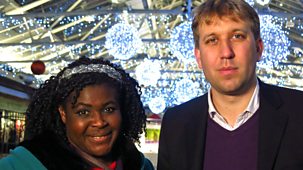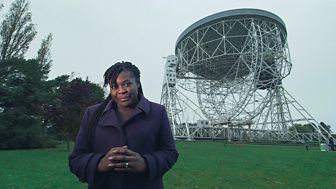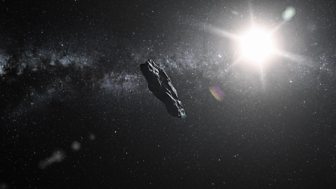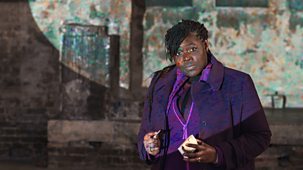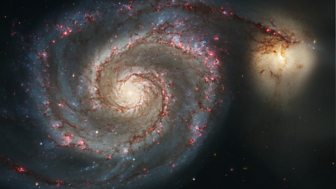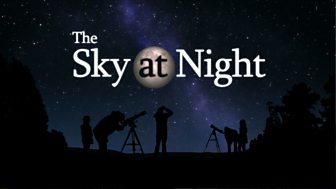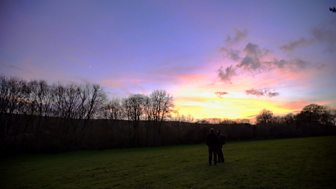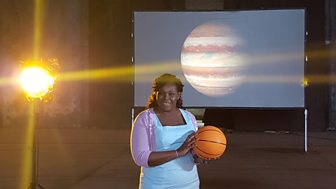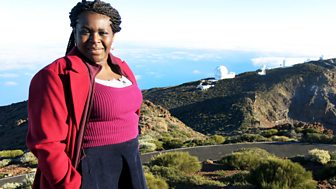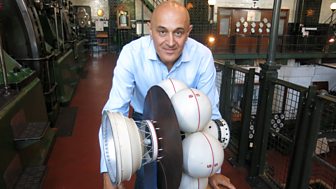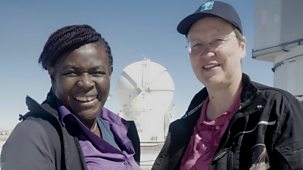
The Very Large Telescope
The Very Large Telescope – or VLT – has been responsible for some of the greatest astronomical breakthroughs of all time, discoveries that have resulted in Nobel Prizes and transformed our understanding of the cosmos. The Sky at Night team travels to the heart of Chile’s Atacama Desert to explore one of the most advanced observatories in the world - a site at the forefront of ground-based optical astronomy.\n\nThe Very Large Telescope, or VLT, is located at the Paranal Observatory, in the Atacama Desert, one of the driest places on earth apart from the North and South Poles, which makes it the perfect place for an observatory because there is little moisture in the air distorting the view of the stars.\n\nThe VLT is actually made up of four main telescopes that can be used individually or have their observing power combined. Each telescope contains a huge 8.2 metre mirror at its heart, designed to capture as much light as possible, and the images obtained from the ground are almost as sharp as those obtained in space.\n\nIn this episode, Maggie meets some of the scientists, engineers and astronomers working at this extraordinary site. Her journey begins by meeting the head of maintenance, support and engineering, Maxime Boccas. He is leading the operation of something that only happens once every two years – the cleaning of the mirrors. Maxime explains the incredible way these huge and delicate mirrors are cleaned and maintained – including the way aluminium particles are vaporised to create perfectly reflective surfaces.\n\nSomeone using the incredible telescopes for their work is astronomer Dr Joe Anderson. Along with other scientists, Joe uses the VLT’s specialised instruments – devices that analyse light from the universe, helping scientists to see and better understand the cosmos. Joe explains that the VLT is the world's most advanced visible-light astronomical observatory, and its huge mirrors and range of instruments mean astronomers can get readings across a broad range of spectrums, which has led to a lot of new discoveries regarding exoplanets, black holes and gamma ray bursts.\n\nThe VLT is a huge site in the middle of a desert, so Maggie next meets Vanessa Peidro, the head of logistics and responsible for maintaining not just the buildings and vehicles but also managing food, water and other facilities that cater for 150-160 people on site at any one time.\n\nMaggie then meets physicist Francoise Delplancke-Stroebele and her colleague Frederic Gonte. They are leading the VLT's next upgrade, Gravity+, and explain how the four massive telescopes at the VLT work in unison by combining light waves in a technique called interferometry. This technique is used by astronomer Dr Abigail Frost, who explains how interferometry helped in the recent discovery of a rare so-called ‘vampire star’.\n\nThe VLT is still a world-class observatory with cutting-edge research, but the site will soon transform into an even more powerful observatory. The Extremely Large Telescope, or ELT, is currently in construction. Maggie gets a sneak peek at what will be, when it’s completed in five years’ time, the biggest optical telescope in the world. Built on top of a mountain and the size of a cathedral, the ELT has to be one of the most spectacular and complex feats of engineering in the world.
Source: BBC 4
Most recent episodes of The Sky at Night
The Sky At Night
Ancestral Skies
This month, The Sky at Night teams up with BBC Ideas to discover the secrets of archaeology and astronomy and to reflect on our ancestral skies. \n\nThroughout history and acros ...
14-11-2024
BBC 4
The Sky At Night
Question Time Special
Get ready for The Sky at Night’s annual Question Time Special, where viewers get the opportunity to ask the questions they have always wanted answered about our universe.\ ...
08-10-2024
BBC 4
The Sky At Night
2075: Our Place In Space
The Sky at Night is embarking on a journey into the future as we explore how space will revolutionise life on Earth over the next 50 years. As humanity's reach extends into the ...
11-09-2024
BBC 4
The Sky At Night
Nicky, Nasa And The Next Frontier
In this Sky at Night special, the team talk to Dr Nicola Fox, NASA’s head of science, whose life began in the UK.\n\nPresenter Chris Lintott chats to Nicky about her early ...
15-08-2024
BBC 4
The Sky At Night
Webb Telescope: The Story So Far
In July 2022, the James Webb Space Telescope released its first images. They were visually stunning, and it was clear they provided more detail of stars, galaxies and planets th ...
11-07-2024
BBC 4
The Sky At Night
Cosmic Ghosts
This month, The Sky at Night has a spooky twist. Across the universe, there are hidden objects that we can’t see, but astronomers and scientists still believe they’r ...
13-06-2024
BBC 4
The Sky At Night
Hiding In Starlight
Total solar eclipses, like the one seen last month in North America, allow us to see details of the Sun that can’t be seen at any other time. So, this month, The Sky at Ni ...
16-05-2024
BBC 4
The Sky At Night
Space Rock Return
The Sky at Night is back for a brand new series, and this month it is delving into Nasa’s OSIRIS-REx mission, which last year brought back a sample from the near-Earth ast ...
11-04-2024
BBC 4
The Sky At Night
The Sky At Night Meets The Infinite Monkey Cage
In this special episode to mark the end of another season of The Sky at Night, we team up with Radio 4’s The Infinite Monkey Cage to talk all things amateur astronomy. Joi ...
16-11-2023
BBC 4
Most popular episodes of The Sky at Night
The Sky At Night
In The Blink Of An Eye
We're used to thinking that the universe operates on timescales of millions or even billions of years, where change happens with imperceptible slowness. But now we've discovered ...
16-11-2017
BBC 4
The Sky At Night
The Mystery Of 'oumuamua
In October 2017, astronomers made a spectacular discovery - they spotted the first ever object to visit our solar system from outer space. They gave it a suitably exotic name... ...
15-02-2018
BBC 4
The Sky At Night
Is Cosmology In Crisis?
Ever since we discovered that distant galaxies are racing away from us, there has been a heated debate over just how fast the Universe is expanding.\n\nAt the beginning of the 2 ...
14-02-2019
BBC 4
The Sky At Night
Wonders Of The Night Sky
The Sky at Night celebrates one of the most profound, moving and enjoyable activities there is - the ancient art of looking up, studying and marvelling at the night sky. The pro ...
10-12-2017
BBC 4
The Sky At Night
The Multiverse Of Mystery
The Sky at Night in the Multiverse of Mystery is a magical journey into the far-flung ideas at the very edge of scientific knowledge, exploring the concepts that today seem like ...
17-11-2022
BBC 4
The Sky At Night
Telescope Takeover
The team travel to the island of La Palma in the Canary Islands where they take control of some of the world's largest telescopes to view the most spectacular sights in the nigh ...
12-02-2017
BBC 4



